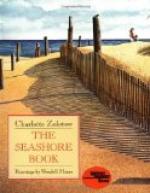THE MUSSEL AND OYSTER.
As everyone knows, the Mussel and the Oyster live between two hinged shells. In the last lesson we called them bi-valve molluscs, which is only another way of saying “soft-bodied animals with two shells.” Have you ever opened an Oyster? It is a tug-of-war, your skill and strength against the muscles of the animal inside the tight shells.
Like the Periwinkle and other shell-builders, these creatures owe their strong houses to a wonderful mantle; but in this case the mantle is in two pieces instead of one. You can imagine the Periwinkle’s mantle as a tube enclosing the animal’s body. The mantle of the Mussel or the Oyster is in two pieces; and each half forms its own shell.
The Snail, and other one-shelled molluscs, poke their heads out of the shell when feeding or moving. Oysters and their two-shelled cousins cannot do this, for the simple reason that they have no heads!
In some places you see that the rocks at low tide are covered with Mussels. In dense black masses they cling to the rocks; and, though heavy waves bang them like so many hammers, they stick tight. Little Mussels and big ones, they form a mass so thick that baby crabs and other creatures use them as a hiding-place. On the piers and groynes, and the woodwork of the harbour, you can see other clusters of Mussels; they are placed where the high tide covers them.
Have you noticed how the Mussel anchors himself? He uses a bunch of threads, like so many cables or tiny ropes. It is interesting to know how these threads are made.
The Mussel is, as a rule, a stay-at-home, but he can move from place to place if he likes. He has a long, slender foot which can be pushed out of the shells. Now the threads are fixed by the foot, just where the Mussel wishes to anchor himself. They are made from a liquid which forms in the body of the creature. This liquid hardens in the water so that it can be pulled out into long, fine threads.
Our ordinary Mussels do not make very long threads, but those of some kinds are so long that they can be woven into silky purses or stockings. The Mussel which makes such long anchor-threads might be called “the silkworm of the sea.”
If the Mussel is such a stay-at-home, how does he find his food? The answer is, that the food comes to him, brought by the ever-moving water. There are countless specks floating in the sea, mostly specks of vegetable stuff. These settle on the floor of the sea, just as dust settles on our house-floors; and the waves wash this “sea-dust” hither and thither. The Mussel or Oyster, with shells gaping wide open, is bound to get some of this food with the water which enters the shells.
The Oyster has no “foot,” and is fixed in one place nearly all its life. It is an interesting animal; and one of such value as food, that hundreds of thousands of Oysters are reared in special “beds,” and sent to the market at the proper season. Our British Oysters were famous even in the time of the Romans; they were carefully packed and sent to Rome, and, at the Roman feasts, surprising quantities of them were eaten.




